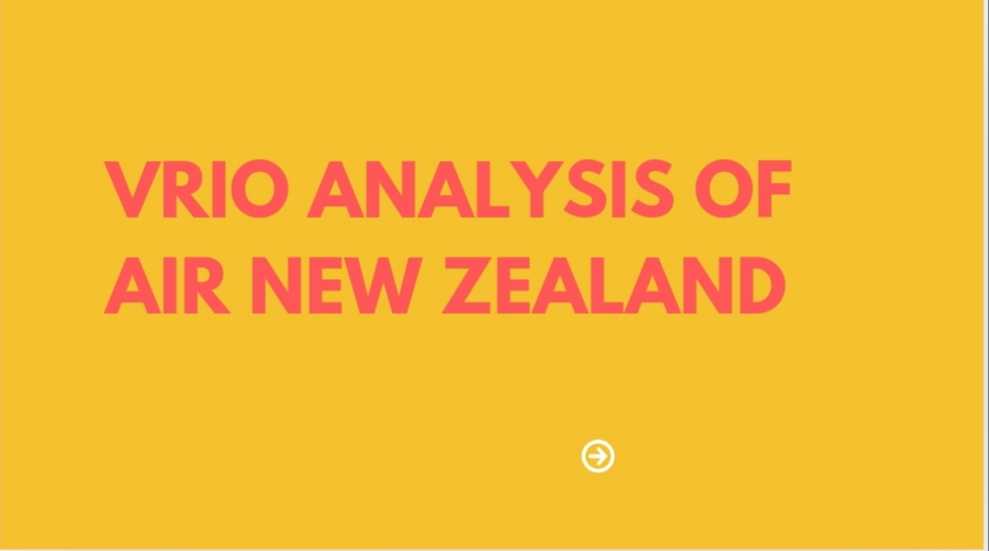A VRIO analysis of Air New Zealand aims to assess the airline’s competitive advantages through the lens of its internal resources and capabilities. By evaluating whether Air New Zealand’s assets and competencies are Valuable, Rare, Imitable, and Organized to capture value, this analysis provides insights into the airline’s strategic positioning and potential for sustained competitive advantage. As a prominent player in the aviation industry, Air New Zealand’s unique resources—including its strong brand reputation, operational efficiency, innovative customer service practices, and extensive network connectivity—serve as key elements for examination. Understanding how these factors contribute to the airline’s performance can reveal the underlying strengths that drive its success in a highly competitive market.
Table of Contents
ToggleValue of Air New Zealand
Air New Zealand’s value can be assessed through several key dimensions that highlight its competitive advantages and strategic positioning within the aviation industry:
1. Strong Brand and Reputation
Air New Zealand’s brand is highly valued for its strong reputation in safety, reliability, and exceptional customer service. The airline is consistently recognized for its high standards and innovative approach, including its iconic and engaging safety videos. This positive brand image helps attract and retain customers and fosters a loyal customer base.
2. Operational Efficiency
The airline’s operational efficiency is a significant asset. Air New Zealand has invested in a modern fleet of fuel-efficient aircraft, which reduces operational costs and aligns with sustainability goals. Additionally, its streamlined processes in flight operations, maintenance, and route management enhance efficiency and reduce overhead costs, contributing to overall profitability.
3. Customer-Centric Innovations
Air New Zealand is known for its innovative approach to enhancing the customer experience. This includes a range of services such as state-of-the-art inflight entertainment systems, personalized service options, and a user-friendly mobile app. These innovations create a superior travel experience, setting the airline apart from competitors and adding considerable value for passengers.
4. Extensive Network and Connectivity
The airline’s extensive network connects major destinations across New Zealand, Australia, the Pacific Islands, and beyond. This broad connectivity provides significant value to both domestic and international travelers. Membership in the Star Alliance further extends its global reach, allowing passengers to access a vast array of destinations and benefits through strategic partnerships with other airlines.
5. Cultural Integration
Air New Zealand’s incorporation of Maori culture into its branding and service offerings adds unique value. This cultural integration enriches the passenger experience and enhances the airline’s appeal, particularly to travelers interested in experiencing New Zealand’s heritage. This distinctive cultural approach differentiates Air New Zealand from other carriers and strengthens its market position.
6. Financial Performance
Historically, Air New Zealand has demonstrated robust financial performance, characterized by profitability, revenue growth, and effective cost management. Strong financial health allows the airline to invest in fleet upgrades, technology advancements, and strategic initiatives, which in turn supports its long-term growth and competitive positioning.
7. Sustainability Initiatives
The airline’s commitment to sustainability and environmental responsibility is a valuable aspect of its operations. Air New Zealand has implemented initiatives to reduce carbon emissions, enhance fuel efficiency, and promote eco-friendly practices. These efforts not only align with global sustainability trends but also resonate with environmentally conscious travelers.
8. Employee Expertise and Engagement
The airline’s dedicated and skilled workforce contributes significantly to its value. Air New Zealand invests in employee training, development, and engagement, fostering a culture of excellence and high performance. This focus on human capital enhances service quality, operational efficiency, and overall customer satisfaction.
9. Strategic Partnerships
Air New Zealand’s strategic alliances, including its membership in the Star Alliance, provide valuable synergies and collaborative opportunities. These partnerships expand the airline’s global network, improve connectivity, and offer additional benefits to passengers, enhancing the overall value proposition.
Rarity of Air New Zealand
In the context of a VRIO analysis, “rare” refers to resources and capabilities that are not widely possessed by competitors. For Air New Zealand, several aspects are considered rare within the global aviation industry:
1. Cultural Integration
Air New Zealand’s integration of Maori culture into its branding and customer service is a rare and distinctive feature. The airline incorporates Maori language, cultural symbols, and traditional practices into its marketing materials, inflight experience, and overall brand identity. This cultural embedding offers a unique customer experience that differentiates the airline from competitors and highlights New Zealand’s heritage in ways that are not commonly seen in other airlines.
2. Innovative Safety Videos
The airline’s creative and humorous safety videos are rare in their approach and execution. These videos have gained international acclaim for their originality and entertainment value, making them stand out in the airline industry. While other airlines produce safety videos, Air New Zealand’s specific style and the cultural references used in these videos are uniquely theirs, creating a memorable brand experience that competitors find difficult to replicate.
3. Unique Brand Positioning
Air New Zealand’s distinctive brand positioning, which combines its commitment to safety, innovation, and cultural heritage, is rare. The airline has effectively carved out a niche in the market by blending these elements into a cohesive brand strategy. This combination of attributes creates a unique value proposition that is not easily duplicated by other airlines.
4. Strategic Alliances
Air New Zealand’s membership in the Star Alliance network is a valuable and rare asset. While many airlines are part of global alliances, the specific benefits and synergies derived from Air New Zealand’s integration within the Star Alliance—such as access to a vast network of destinations and collaborative operational efficiencies—are unique to its position within the alliance.
5. Extensive Pacific Connectivity
Air New Zealand’s extensive network and strong presence in the Pacific region are rare among global airlines. The airline’s dominant role in connecting New Zealand with numerous destinations in the Pacific Islands provides it with a significant competitive edge. This specialized regional connectivity is a unique strength that few other airlines possess to the same extent.
6. Local Market Expertise
The airline’s deep understanding of the New Zealand market and its specific needs is a rare asset. This expertise allows Air New Zealand to tailor its services and marketing strategies effectively for both domestic and international travelers. The local knowledge and market adaptability that Air New Zealand possesses are not easily replicated by competitors who do not have the same level of immersion in the New Zealand market.
7. Sustainability Focus
While many airlines are increasing their focus on sustainability, Air New Zealand’s comprehensive approach to environmental responsibility, including its early adoption of fuel-efficient technologies and carbon reduction strategies, is relatively rare. The depth of commitment and the specific sustainability initiatives the airline has implemented distinguish it from many competitors.
Imitability of Air New Zealand
1. Cultural Integration
Air New Zealand’s integration of Maori culture is a significant part of its brand identity and customer experience. This deep-rooted cultural integration involves not just superficial branding but also authentic and meaningful incorporation of cultural elements into the airline’s operations and services. While other airlines might attempt to adopt elements of local cultures, replicating the genuine and embedded cultural integration that Air New Zealand has achieved is challenging. The authenticity and depth of this cultural connection are difficult for competitors to mimic.
2. Innovative Safety Videos
The airline’s safety videos are known for their creativity, humor, and cultural references, setting them apart from the standard safety briefings found on other airlines. While competitors can create their own safety videos, the specific style, high production values, and unique content of Air New Zealand’s videos are difficult to replicate exactly. The originality and memorable nature of these videos have become a hallmark of Air New Zealand’s brand, making them hard for others to imitate in the same impactful way.
3. Brand Reputation and Customer Loyalty
Building a strong brand reputation and a loyal customer base similar to Air New Zealand’s requires considerable time, consistent performance, and significant investment. The trust and loyalty the airline has earned are the result of years of delivering high-quality service and maintaining a strong safety record. Competitors may struggle to achieve the same level of brand equity and customer loyalty, as these are outcomes of long-term, consistent efforts and excellent performance.
4. Operational Efficiency and Fleet Management
While competitors can invest in modern fleets and technology, the specific operational efficiencies that Air New Zealand has developed over time are challenging to imitate. These efficiencies include optimized flight operations, advanced maintenance practices, and cost management strategies that have been refined through years of experience. Replicating the precise balance of these operational practices requires substantial time and resources.
5. Strategic Alliances and Network Integration
Air New Zealand’s integration into the Star Alliance network offers extensive global connectivity and collaborative benefits. While other airlines can join alliances, the depth of integration and the specific synergies Air New Zealand enjoys within the Star Alliance are not easily replicated. The airline’s established relationships and network connections within the alliance provide competitive advantages that take time and effort to achieve.
6. Local Market Expertise
The airline’s deep understanding of the New Zealand market and its ability to tailor services specifically for local and international travelers is a unique advantage. This level of market insight and adaptation is the result of years of operating within the local context. Competitors who do not have the same level of local expertise may find it difficult to replicate the same level of market responsiveness and service customization.
7. Sustainability Initiatives
Air New Zealand’s commitment to sustainability, including its early adoption of fuel-efficient technologies and comprehensive carbon reduction strategies, is another aspect that is difficult for competitors to imitate quickly. The airline’s established track record in sustainability reflects a long-term commitment and investment that cannot be easily or rapidly replicated by others.
Organization of Air New Zealand
In a VRIO analysis, “organization” refers to how well a firm is structured to utilize its resources and capabilities effectively. For Air New Zealand, several organizational aspects contribute to its ability to leverage its valuable, rare, and difficult-to-imitate resources, ensuring that it can capture value and maintain a competitive edge:
1. Strategic Leadership and Governance
Air New Zealand benefits from a well-defined leadership structure and governance framework that guides its strategic direction. The board of directors and executive management team provide experienced leadership and strategic vision, ensuring that the airline’s resources and capabilities are aligned with its long-term goals. Effective decision-making processes and governance structures support the airline’s strategic initiatives and operational efficiency.
2. Integrated Operational Systems
The airline’s operations are highly integrated and streamlined, allowing for efficient management of its fleet, routes, and services. Air New Zealand employs advanced operational systems for scheduling, maintenance, and resource allocation. This integration helps optimize performance, reduce costs, and improve service quality. Coordinated operational management ensures that the airline can efficiently respond to market demands and operational challenges.
3. Cultural and Organizational Alignment
Air New Zealand has cultivated a strong organizational culture that aligns with its strategic objectives. The company promotes a culture of safety, customer service, and innovation, which is reflected in its day-to-day operations and employee interactions. This cultural alignment ensures that employees are motivated and engaged, which enhances service quality and operational performance.
4. Customer-Centric Approach
The airline is organized around a customer-centric model, with dedicated teams and processes focused on improving the passenger experience. This includes departments responsible for customer service, inflight experience, and digital engagement. By prioritizing customer needs and preferences, Air New Zealand ensures that its resources are effectively used to enhance the overall travel experience, thereby fostering customer loyalty and satisfaction.
5. Innovation and R&D Focus
Air New Zealand’s organizational structure supports innovation through dedicated research and development (R&D) initiatives. The airline invests in new technologies, service improvements, and sustainability practices, which are integrated into its business operations. The R&D focus allows Air New Zealand to stay ahead of industry trends and continuously enhance its offerings, maintaining its competitive edge.
6. Effective Resource Allocation
The airline’s resource allocation strategies ensure that financial, human, and technological resources are deployed efficiently. This includes investments in fleet upgrades, technology enhancements, and employee training. By strategically allocating resources, Air New Zealand maximizes the value derived from its investments and supports its operational and strategic objectives.
7. Strategic Alliances and Partnerships
Air New Zealand’s membership in the Star Alliance network and its other strategic partnerships are well-organized to leverage global connectivity and collaborative opportunities. The airline manages these alliances effectively to enhance its network reach, operational synergies, and customer benefits. The organization’s ability to integrate and manage these partnerships contributes to its competitive positioning and market reach.
8. Sustainability and Corporate Responsibility
Sustainability and corporate responsibility are embedded in Air New Zealand’s organizational practices. The airline has established processes and policies to address environmental impacts, promote sustainability, and engage in corporate social responsibility initiatives. This organizational focus on sustainability aligns with global trends and customer expectations, enhancing the airline’s reputation and operational practices.
9. Employee Development and Engagement
Air New Zealand places a strong emphasis on employee development and engagement. The airline invests in training programs, career development opportunities, and a positive work environment. Engaged and well-trained employees contribute to high service standards and operational efficiency, supporting the airline’s overall performance and strategic goals.


